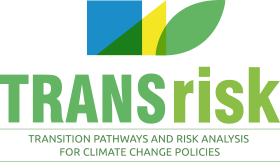
TRANSrisk – Transitions pathways and risk analysis for climate change mitigation and adaption strategies
Project Overview
TRANSrisk is a EU-funded research project studying the risks and uncertainties within low carbon transition pathways, and how transitions can be implemented in ways that are technically, economically and sociably feasible. The project’s objective is to produce a new assessment framework, and an accompanying toolbox, for policy makers.
TRANSrisk’s unique approach sees us combining economic computer models with input from people working in the area of study (’stakeholders’). Models provide a useful means of predicting the future impacts of decisions we take now, but factors such as political opinion and public acceptability are very difficult to predict via a purely numerical approach. TRANSrisk is using stakeholder input to feed our models, and is presenting the results back to stakeholders to see how this affects their views.
14 country case studies lie at the core of TRANSrisk’s work. Each case study is focusing on key economic sectors and low carbon technologies for the country in question. To fully understand the range of transition pathways our case studies encompass the globe: from Europe and North America to the fast growing economies of Asia, Africa and Latin America. Each case study is led by expert academics based in the study country.
Ultimately TRANSrisk’s outputs will help policy and decision makers implement more effective climate change policy, and improve their understanding of the costs, benefits, risks and uncertainties of rolling out low carbon technologies.
Project Results
TRANSrisk developed tools to help researchers and policy makers evaluate options for low carbon transition pathways. Some of our tools can help to explore, categorise and analyse the expertise of key sector stakeholders. Others can help make quick and easy estimates of the impacts of proposed policy changes; these, for example, can be used to inform sector stakeholders about the economic impacts of potential low carbon pathways. 14 case studies have been analysed beloging to 14 different geographic area and 14 different technological applications. A considerable Virtual Library is accessible form the website which includes interesting research documents focused on policy making process.

